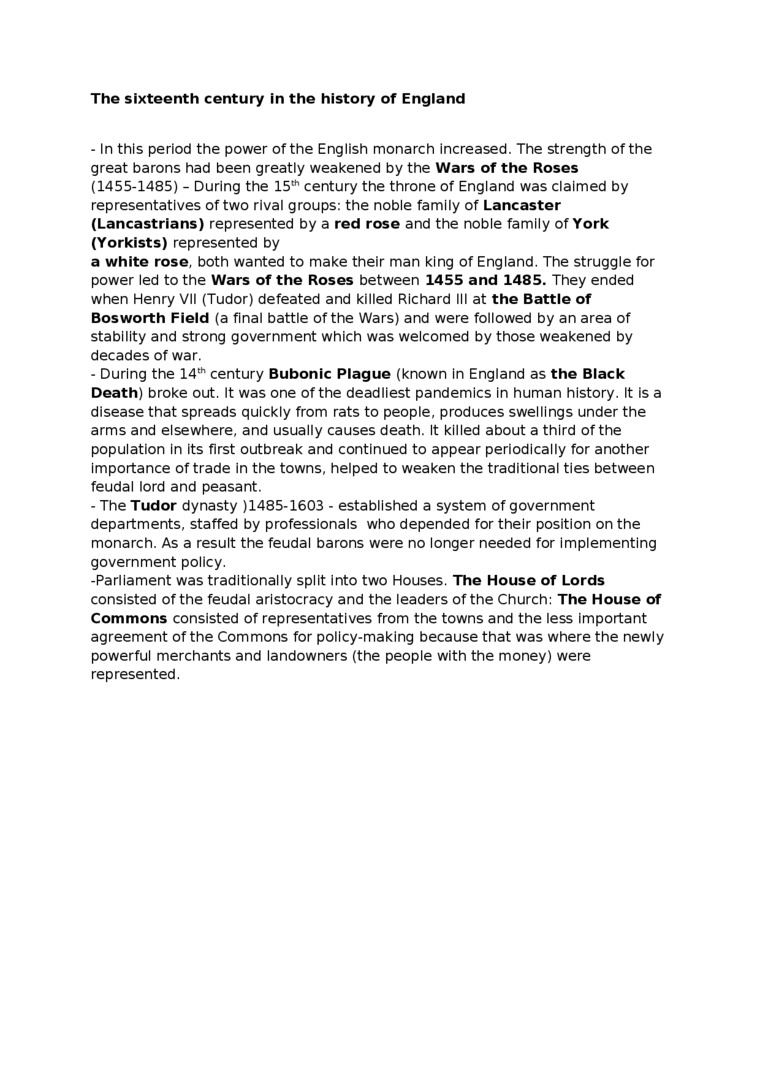95461

The sixteenth century In the history of England
- In this period the power of the English monarch increased. The strength of the great barons had been greatly weakened by the Wars of the Roses (1455-1485) - During the 15th century the throne of England was claimed by representatives of two rival groups: the noble family of Lancaster (Lancastrians) represented by a red rosę and the noble family of York (Yorkists) represented by
a white rosę, both wanted to make their man king of England. The struggle for power led to the Wars of the Roses between 1455 and 1485. They ended when Henry VII (Tudor) defeated and killed Richard III at the Battle of Bosworth Field (a finał battle of the Wars) and were followed by an area of stabllity and strong government which was welcomed by those weakened by decades of war.
- During the 14th century Bubonic Plague (known In England as the Black Death) broke out. It was one of the deadliest pandemics in human history. It is a disease that spreads quickly from rats to people, produces swellings under the arms and elsewhere, and usually causes death. It killed about a third of the population In its first outbreak and continued to appear periodically for another importance of trade in the towns, helped to weaken the traditional ties between feudal lord and peasant.
-TheTudor dynasty )1485-1603 - established a system of government departments, staffed by professionals who depended for their position on the monarch. As a result the feudal barons were no longer needed for implementing government policy.
-Parllament was tradltionally split into two Houses. The House of Lords consisted of the feudal aristocracy and the leaders of the Church: The House of Commons consisted of representatives from the towns and the less important agreement of the Commons for policy-making because that was where the newly powerful merchants and landowners (the people with the money) were represented.
Wyszukiwarka
Podobne podstrony:
33861 m1451 Many Continental mercenaries fought in England during this period. This contemporary dra
m1453 ‘pattens’—widely worn in this period as extra outdoor protection against wet and mud. Both A2
DSCF0023 ESSAYS IN SWEDISH HISTORY compared with that of Polish infantry of the mid-sixteenth centur
Waldemar Deluga The History of Studics over the Orthodos Art on the Turn of the 19th and 20th Centur
History of England - Important dates from the 18th century -1707 The Act of Union joins the Parliame
The history of the chancellery in XIX-XXth centuries I. WIEDZA Po ukończeniu studiów absolwent: 1.
Luftwaffe The Illustrated History of the German Air Force in WWII Jitftnwffe The iliustraled tu stor
egz1 History of English - FINAŁ EXAM YEAR III The most important force in shaping
Aestimatio : Critical Reviews in the History of Science Aetas: tortenettudomanyi folyóirat Aether Ae
HOE1 y.Ao.oy A Why should we be interested in the history of language? v •i Should there be a standa
Finally, (13) »A History of Fortune* (1522, in the 2-nd edit-ion of 1524 called »Fortunek and Virtue
VI Obituary Those early years in the history of the Gliwice Radiocarbon Laboratory are documented in
FOOTBALL 1914 The football season of 1914 will be remembered in tbe history of Salem High School in
272 SHORT NOTES of the knights’estate in the second half of the 12th century; in the 14th century
więcej podobnych podstron